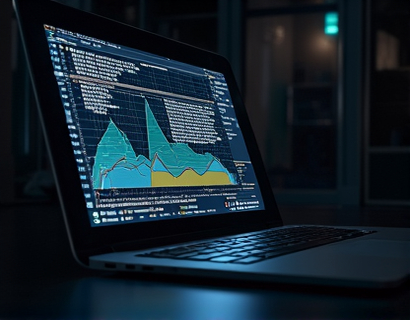Unlocking Tokenization: Leveraging Smart-Contract Innovation for UCASH and U Asset Management
In the rapidly evolving landscape of digital finance, tokenization has emerged as a transformative force, offering unprecedented opportunities for asset management and security. This article delves into the intricacies of tokenization, focusing on how smart-contract innovation can elevate the management of digital assets, particularly those pegged to leading cryptocurrencies like UCASH and other U assets. By exploring the technical and practical aspects of this technology, we aim to provide a comprehensive understanding of how tokenization can revolutionize your financial ecosystem.
Understanding Tokenization
Tokenization refers to the process of converting rights to an asset into a digital token on a blockchain. These tokens represent a fraction of the asset's value and can be traded, transferred, and managed digitally. The use of blockchain technology ensures transparency, security, and immutability, making tokenization an attractive solution for asset management.
The concept of tokenization is not new, but its application in digital asset management is relatively recent. Traditional asset management involves physical documents, intermediaries, and manual processes, which are prone to errors and inefficiencies. Tokenization streamlines these processes by digitizing assets, reducing costs, and enhancing transparency.
Smart Contracts: The Backbone of Tokenization
Smart contracts are self-executing contracts with the terms of the agreement directly written into code. They run on blockchain networks and automatically enforce and execute the terms of the contract when predefined conditions are met. In the context of tokenization, smart contracts play a crucial role in creating, managing, and transferring tokens.
For UCASH and U assets, smart contracts ensure that tokens are pegged to the value of these assets in a secure and transparent manner. The smart contract defines the rules for token issuance, redemption, and value maintenance, eliminating the need for intermediaries and reducing the risk of fraud or manipulation.
Benefits of Smart-Contract-Based Tokenization
The integration of smart contracts in tokenization offers numerous benefits, making it an attractive solution for asset managers and investors alike.
- Security: Smart contracts are stored on a blockchain, which is inherently secure and resistant to tampering. This ensures that token transactions are immutable and verifiable.
- Efficiency: Automated execution of smart contracts reduces the need for manual interventions, speeding up processes and lowering operational costs.
- Transparency: All transactions and contract terms are visible on the blockchain, providing a high level of transparency and trust among participants.
- Accessibility: Tokenization makes it easier for a broader range of investors to participate in asset management, as tokens can be bought and sold like any other digital asset.
Creating Tokens for UCASH and U Assets
To leverage tokenization for UCASH and U assets, the first step is to design a robust smart contract that defines the token's behavior. This involves several key components:
- Token Standard: Choosing the right token standard is crucial. For UCASH and U assets, the ERC-20 standard on the Ethereum blockchain is commonly used due to its widespread adoption and flexibility.
- Peg Mechanism: The smart contract must include a mechanism to maintain the token's value peg to UCASH or other U assets. This typically involves algorithmic adjustments or collateralization to ensure stability.
- Issuance and Redemption Rules: The contract should outline clear rules for token issuance and redemption, including conditions under which tokens can be created or destroyed.
- Governance: Implementing a governance model within the smart contract allows token holders to participate in decision-making processes, ensuring the token's long-term viability and alignment with user interests.
Once the smart contract is deployed, it manages the lifecycle of the tokens, from creation to destruction, ensuring that the token's value remains tied to the underlying asset.
Enhancing Asset Management with Tokenization
Tokenization not only simplifies the management of UCASH and U assets but also enhances the overall asset management process. Here are some ways in which tokenization can elevate your financial ecosystem:
Firstly, tokenization improves liquidity. Traditional assets are often illiquid, making it difficult to buy or sell them quickly without affecting their price. Tokens, on the other hand, can be traded on decentralized exchanges 24/7, providing greater liquidity and flexibility.
Secondly, tokenization reduces costs. By eliminating intermediaries such as brokers and custodians, the tokenization process lowers transaction fees and operational expenses. This makes asset management more cost-effective and accessible.
Thirdly, tokenization enhances transparency and trust. The immutable nature of blockchain ensures that all transactions are recorded and verifiable, reducing the risk of fraud and increasing trust among stakeholders.
Lastly, tokenization enables new investment opportunities. Smaller investors who might not have had access to certain assets can now participate through tokenized representations, democratizing the investment landscape.
Challenges and Considerations
While the benefits of tokenization are significant, there are also challenges and considerations to keep in mind:
First, regulatory compliance is a critical aspect. The legal status of tokens and blockchain-based assets varies by jurisdiction, and ensuring compliance is essential to avoid legal issues.
Second, technical complexity is a barrier for some organizations. Implementing smart contracts and blockchain solutions requires specialized knowledge and expertise, which may necessitate partnerships with blockchain developers.
Third, market volatility can impact the value of tokenized assets. While pegging to UCASH or other U assets helps stabilize token value, market conditions can still affect the overall ecosystem.
Addressing these challenges proactively can help maximize the benefits of tokenization and ensure a smooth transition to a more efficient and secure asset management system.
Future Prospects
The future of tokenization and smart-contract innovation looks promising, with ongoing developments in blockchain technology and increasing adoption across industries. For UCASH and U assets, the potential is vast:
First, the integration of advanced features such as decentralized finance (DeFi) protocols can enhance the functionality of tokenized assets, offering more sophisticated investment and lending options.
Second, interoperability between different blockchain platforms can expand the reach and utility of tokens, allowing for seamless interactions across various ecosystems.
Third, the evolution of scalability solutions will address current limitations, enabling faster and more cost-effective transactions, which is crucial for widespread adoption.
By staying ahead of these trends and continuously innovating, organizations can harness the full potential of tokenization to transform their asset management practices.
In conclusion, tokenization, powered by smart-contract innovation, offers a powerful tool for enhancing the security, efficiency, and accessibility of UCASH and U asset management. By embracing this technology, organizations can unlock new opportunities and elevate their financial ecosystems to new heights.










































